How to Leverage Pricing Governance to Safeguard the Topline
While crucial, product-level brand strategies or launch strategies are not sufficient to ensure the long-term success of a product. Best-in-class companies are set apart by their internal pricing governance, write Stephan Schurz and Dr. Fangting Yu.
How should pharmaceutical companies navigate the complex global pricing dynamics in the industry and stay in control of their pricing? How can companies ensure that their global pricing is aligned with the company strategy? How should companies set prices and deal with price changes in global markets, considering the impact of International Reference Pricing (IRP)? Robust pricing governance is the solution. While crucial, product-level brand strategies or launch strategies are not on their own sufficient to ensure the long-term success of a product in the dynamic pharmaceutical industry. Across the industry, best-in-class companies are set apart by their internal pricing governance, which entails structured and clear processes, defined responsibilities, and on-point execution throughout the full life cycle of a product.
What is pricing governance?
Pricing governance is one of the pillars of pricing excellence. For a pharmaceutical or biotech company, it is the way pricing and market access decision-making is controlled at specified levels of hierarchy with the aim of effective and efficient steering, implementation monitoring and reporting on pricing. This is illustrated in the Pricing Excellence Framework below (Figure 1).
Click to enlarge
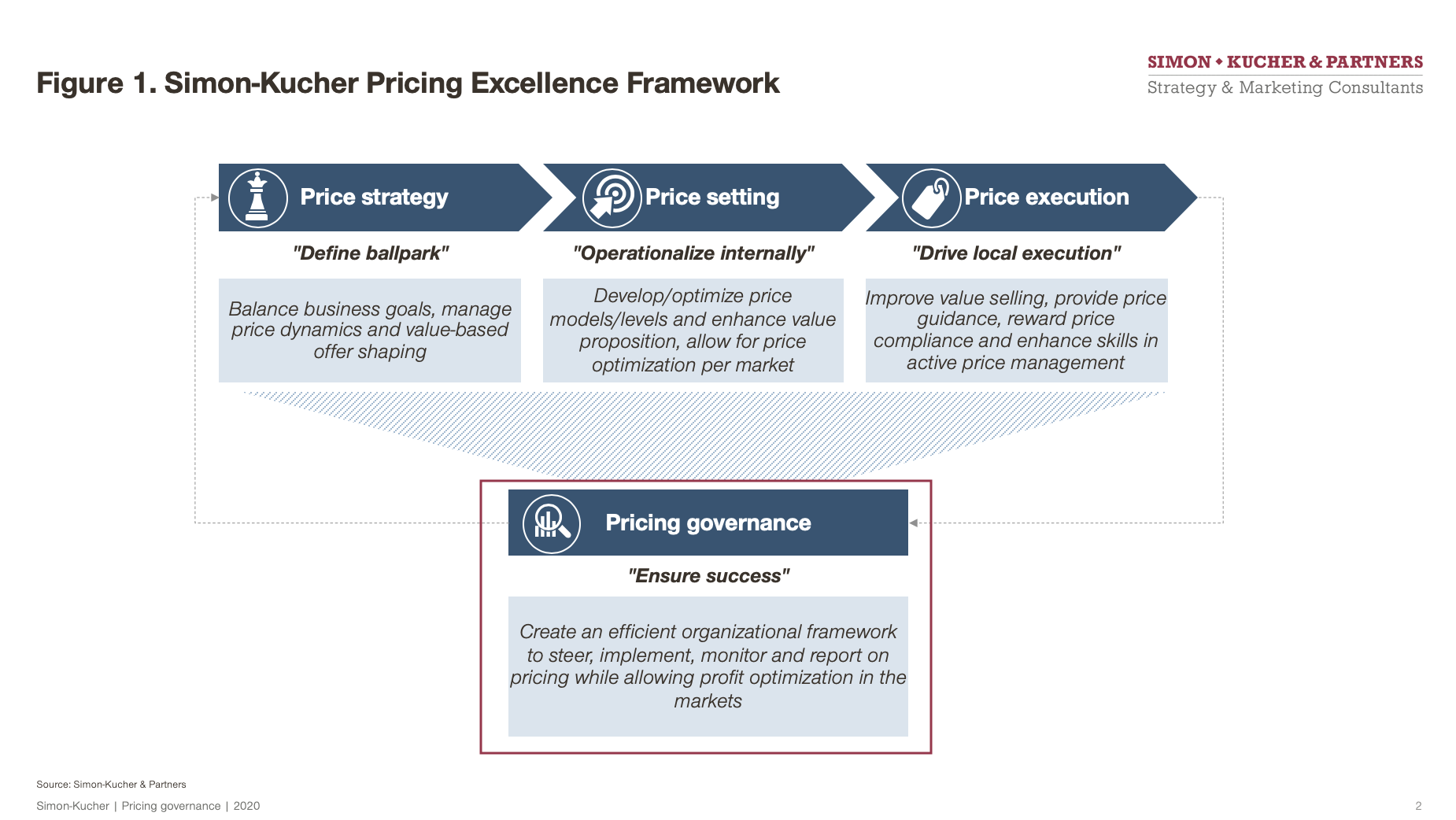
Optimal global pricing governance captures a product’s price potential without stifling opportunities or overwhelming the organization with administrative processes. While the principles of pricing governance may be universal, the characteristics of its implementation are unique for every company, therefore, we are not trying to describe a one-size fit all solution. First, we will describe a few blinded cases in the pharma industry, to provide a flavor of different aspects of pricing governance. Then we will discuss the components of pricing governance to highlight some fundamental principles.
Industry case study
Case study 1: Region-led pricing governance goes global
The pricing governance of a global pharmaceutical company was traditionally executed on a regional level. The company has a broad portfolio spanning from primary care (CV, diabetes, etc.) to oncology and orphan indications. The region-governed pricing practice was sufficient for each individual region, but unavoidably led to some global price erosion because of IRP due to the lack of coordination between the regions. Looking for more consistency in management approach and deliverables, a framework was developed to integrate the current best practice in price management from different regions and define an updated global pricing governance process.
During the development of this framework, a fact base was first built to catalogue the status quo from key regions and to understand the best practices and areas of improvement. A scoring sheet was used to evaluate the current status regarding pricing committee set-up, list price guidance, net price guidance, and partner management. Then a “future state” was defined via collaborations and workshops between global and regional pricing personnel. This future state defines the vision for the new pricing governance to be holistic and pragmatic, and constructs the guiding principles for pricing governance on pricing rationale, strategic considerations, visibility and transparency. After defining the status quo and the future state, the matter was “how to get there.”
A framework was developed aiming to bring the organization from the status quo to the future state. In this framework, the governing bodies and their corresponding accountabilities and responsibilities were defined based on the type of price approval / decision. For example, Figure 2 shows a blinded example of approval of net and list price change requests for in-line products. Again, because this organization originally relied on regional pricing governance, regions still play an important role in making decisions for net price approvals, whereas the global organization is informed of the regional net price decisions. List price approvals, however, have more global implications because of IRP, therefore, global endorsement is required.
Click to enlarge

Learnings: Global involvement is necessary in pricing governance. For a traditionally region-governed organization, harmonizing and integrating the current practice is critical.
Cast study 2: Pricing governance for biosimilars
Simon-Kucher’s Global Pricing Study shows that companies always point to the competitors for starting a price competition. When competitors claim market share via steep discounts in price sensitive markets, efficient pricing governance is critical to prevent value destruction for the entire market. A biopharma company with a diverse portfolio has been operating with established pricing governance on global, regional, and affiliate levels and the pricing governance has grown organically with the growth of the organization. In preparation for its existing and upcoming biosimilar launches, the company initiated the process of updating its pricing governance, with a focus on separating biosimilar vs. non-biosimilar governance.
Biosimilars are particularly susceptible to price pressure from competitive dynamics. They typically have a more condensed product lifecycle, i.e., shorter time to market and compressed launch sequence, and are at risk of becoming low-priced commodities because of likely faster price erosion than patented brands. In addition, account managers for biosimilar products may not place a strong focus on value deals but go after each and every deal to increase sales. Due to these features, companies with biosimilar products in their portfolio should consider setting up specific biosimilar pricing governance.
The approach for developing an updated pricing governance process for biosimilar products is somewhat similar to the case study above. However, pricing governance for biosimilars in this organization has some unique features as compared to its non-biosimilar products (not exhaustive):
• List price floors are country-specific and not global list floors: This setup simplifies floor price setting for launch list prices per country, which will be solely based on local P&R rules and market expectations / dynamics.
• Higher scrutiny when a list price reduction is requested by an affiliate: Two situations may apply here. The price reduction could be imposed by country-specific regulations, or an affiliate initiates a price reduction to gain better access. If the requested list price reduction is below the country-specific floor, regional approval is typically required, taking into consideration the strategic need for list price change, impact on parallel trade, reference pricing impact, impact on net price, sales volume, hospital margins, etc.
• A mid-term net floor forecast (2~5 years) to help avoid short-term thinking and facilitate strategic planning: At launch, net floor target and the average selling price (ASP) target are set and communicated for year 1 and with a forecast for year 2~3. The forecast provides affiliates mid- to long-term strategic guidance on their discounting behavior and allows forward-looking view in case of a multi-year contract. However, this approach may also lead to affiliates knowing the future lower price floor and engaging in lower-priced deals in year 1.
• Higher level of price × volume controls: For a deal that is critical to the ASP (can be defined by discounting grid, price × volume matrix, or the ASP floor), relevant regional stakeholders, e.g., Regional Commercial and Pricing teams, need to be involved for deal approval, taking into consideration the volume of the deal, requested net price, overall ASP impact, and any additional strategic justification.
Learnings: Pricing governance for biosimilars should bring internal controls in balance with the specific market dynamics of biosimilars. Companies should be proactive with checks and balances in the pricing governance process and frequently review and adjust the price floors.
Key components of pricing governance
Successful pricing governance usually includes a few key components, as illustrated in Figure 3.
Click to enlarge
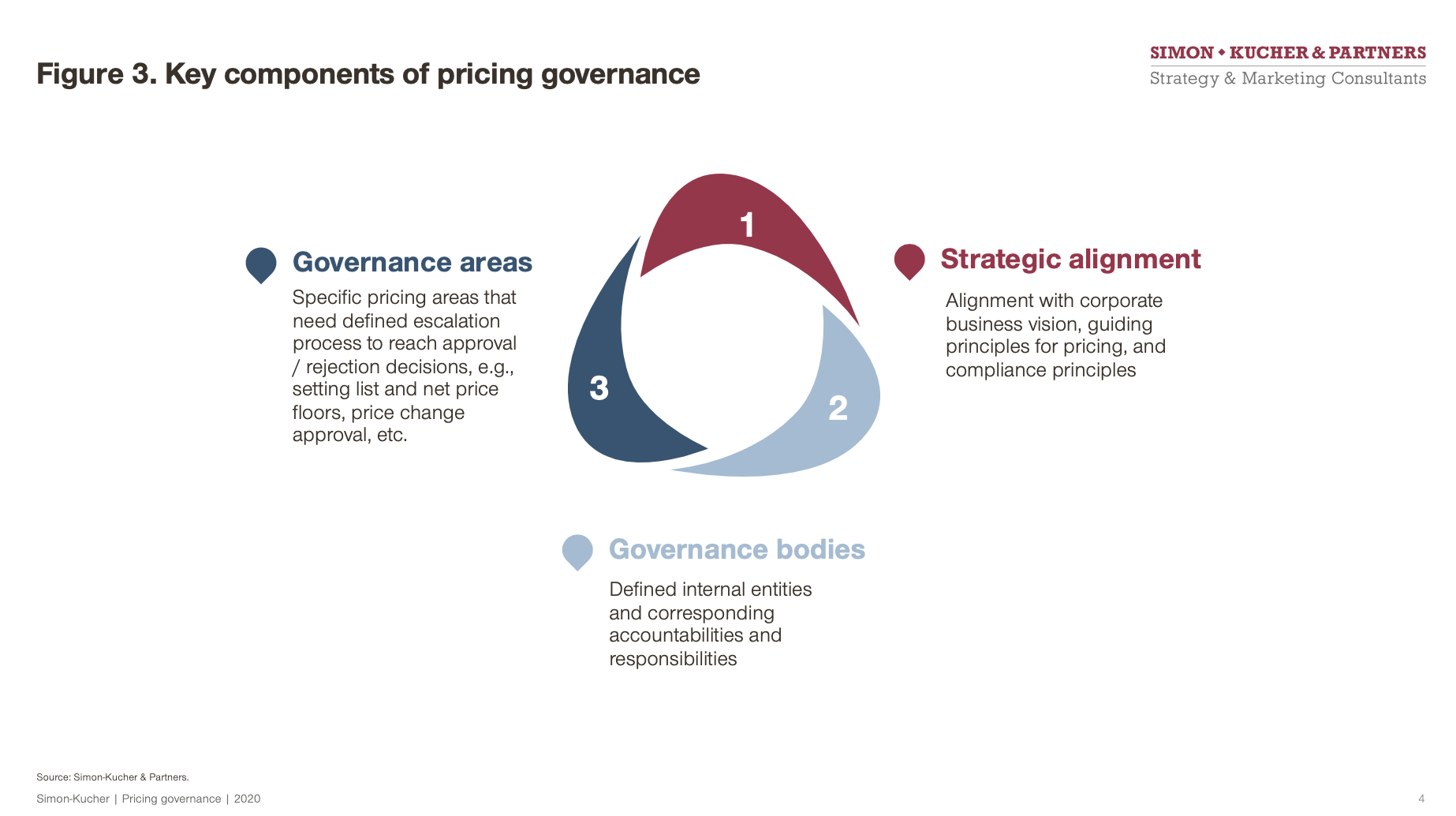
- Strategic alignment
It is crucial that the goal of pricing governance is aligned with the corporate vision and reflects the core values of a company. Taking a top-down view, the corporate vision and values should be embedded into brand strategies, then reflected in the pricing and access strategies. Pricing governance ensures that the pricing strategies are executed appropriately. It can be used as an effective vehicle to optimize prices for pipeline and in-line products to fully capture the value of the therapies. Therefore, the overall guiding principles of pricing governance should be aligned with the corporate vision.
- Governance bodies
The pricing governance bodies involved in pricing decisions vary by the magnitude of business risk/impact of the decision. The guiding principle is that the higher impact/risk, the higher the hierarchy required for the final decision, as illustrated in Figure 4. Of course, it is rare to see senior management making a direct pricing decision for a certain product. That is why a lot more thoughts need to go into designing the pricing governance bodies to maintain efficiency and organizational agility in a competitive market space.
Click to enlarge

• Centralization, decentralization, and the level of hierarchy
There is no “one” best practice when it comes to the degree of centralization and decentralization in pricing decisions. It ultimately depends on senior management to decide how much they are comfortable “letting go”. There are pros and cons associated with centralization vs. decentralization, and the level of hierarchy (Figure 5).
In general, centralization creates better streamlined processes and drives consistency between decisions. Decisions coming from top management tend to have a signaling effect. A higher hierarchy in pricing decisions is especially important for organizations that face on-going or imminent price erosion challenges, as pricing needs to be a top priority. The issue with centralization is the possibility to create a bureaucratic process with delays. Given these pros and cons, organizations need to select only the crucial pricing decisions to be escalated to senior management. Decentralization allows agility in pricing decisions. As local pricing governance bodies are closer to the market and end customers, decisions tend to lean towards catering to the market needs: more often than not, this could lead to lower local net prices. An escalation threshold is typically set to balance the local flexibility and central control of the net prices. The bottom line is that not all pricing decisions need to be made centrally. A good balance between centralization and decentralization can achieve consistency, flexibility, and organizational agility.
Click to enlarge
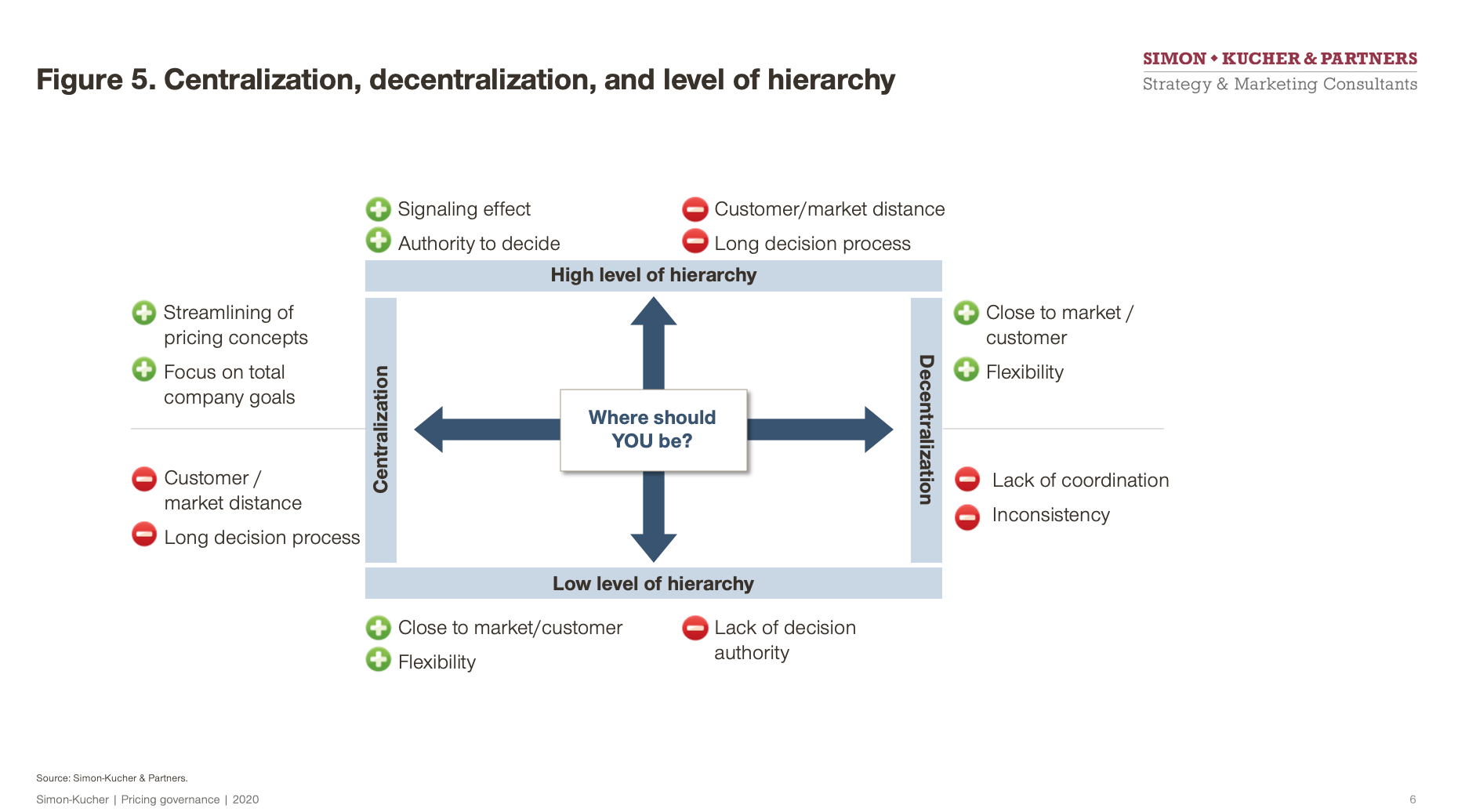
- Governance areas
Pricing governance usually covers all products in the company’s portfolio. For some large global companies, their portfolio includes hundreds of products. Even for clinical stage or mid-sized companies, resources should not be allocated evenly for the global pricing governance of each asset in the portfolio. One aspect to ensuring efficiency and agility is to categorize products into tiers. The approach could differ based on the type of product portfolio, but the basic principle is the same: The more important a product is, the higher hierarchy of governance bodies should be involved in making its pricing decisions; in most cases, the higher chain of command is manifested by the involvement of global senior management.
• Product tiers
We outline here some considerations when tiering the products for pricing governance, see Figure 6. Please note that these considerations are not meant to be mutually exclusive or exhaustive.
Click to enlarge
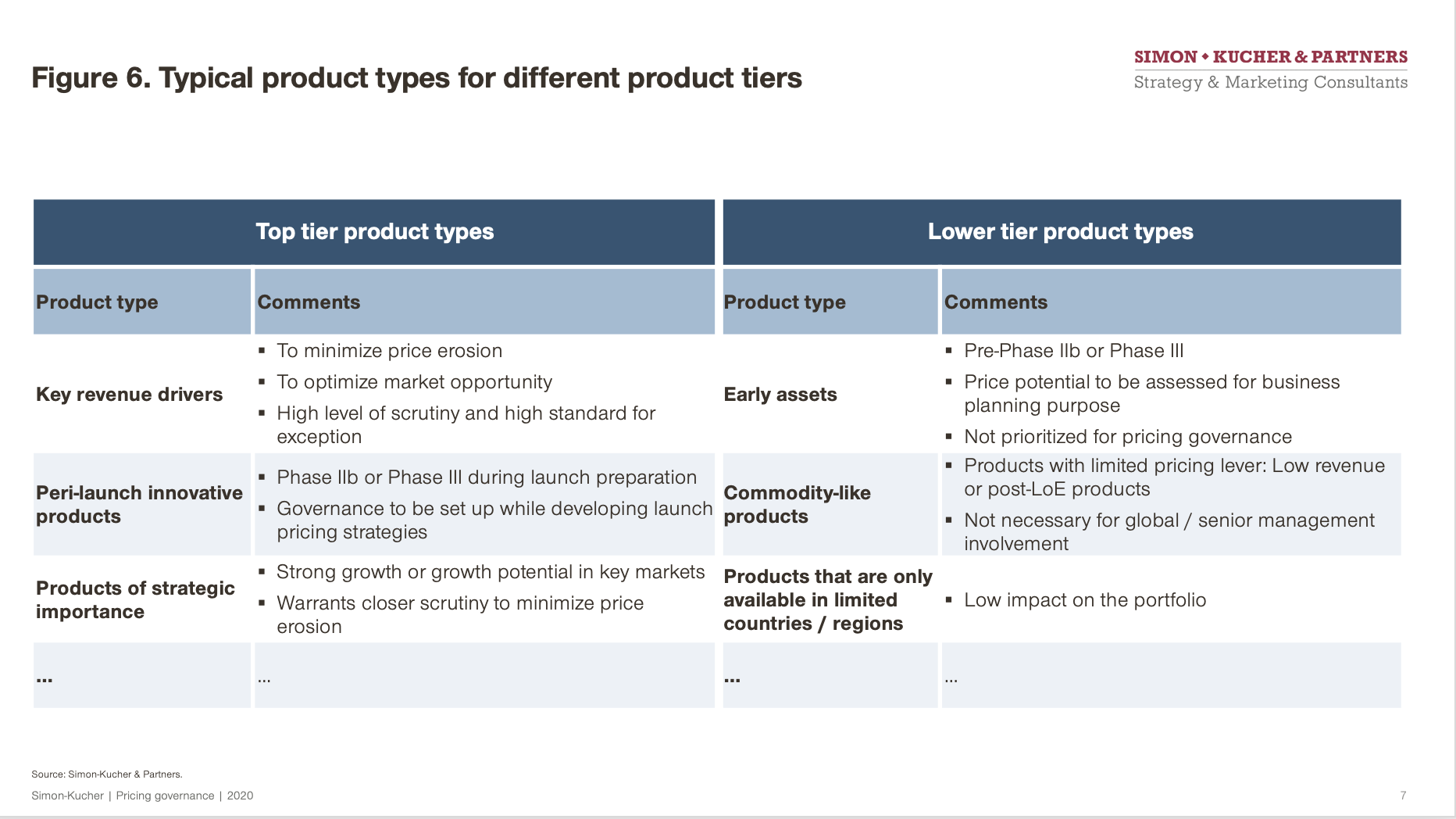
Technically, all pricing decisions, including setting list/net prices and floors, tender bids, management of discounts to payers, etc. should all fall under the purview of pricing governance. However, for simplicity, we only highlight a few pricing decisions that are typically included as a part of global pricing governance and describe the common setup for these governance areas. A word of caution: Depending on the organizational structure, the processes and setups could be different from the description here; however, the guiding principles and key concepts should not vary dramatically.
• Setting and updating the absolute net price floor
An absolute net price floor is a price floor that defines the net price level below which a product can no longer be sold profitably or sustainably. Any price change request that goes below the absolute net price floor should only be approved under very exceptional circumstances by a high level of authority. This price is the absolute lowest net price, inclusive of all discounts, rebates, free goods, paybacks, clawbacks, patient assistance programs, etc., and it represents the profitability limit of any given product. It is usually determined as COGS plus a certain percentage. The absolute net price floor is typically defined by the Global Finance function because it should be a pure financial decision, and is approved by a higher commercial authority. Global Pricing and other relevant functions should be informed. However, since this is an absolute lowest price at which a product can be sold, it is usually not visible to all pricing personnel. Only specified Global Pricing personnel has access to this information.
• List and net price escalation thresholds and price approvals
Often on a per region basis, a list price escalation threshold is usually set to help mitigate the risk of International Reference Pricing (IRP) and to provide list price guardrails within each region. In the event that a list price change request is below the list price escalation threshold, global oversight is needed because this is beyond the organization-dependent “tolerance level” of the impact of IRP. On the other hand, any list price changes above the escalation threshold can be carried out within the local or regional pricing governance bodies.
The net price escalation threshold is also typically set up on a per country/region basis, as net price guardrails to achieve business targets. Similar to the governance list price change request, when a net price change request is below the defined threshold, regional/global involvement in decision-making usually occurs; otherwise, the decision-making authority lies within the country.
• Setting and updating the list and net price escalation thresholds
Be it the list or net price escalation threshold, setting and updating these thresholds should involve both global and regional pricing personnel. The thresholds can be set depending on the level of centralization/decentralization an organization strives for. To determine this threshold, data analytics should be carried out to understand what are the current list and net prices across all markets, and take a fixed percentage below the current list / net price. Depending on the strategic importance of the product, this percentage could be very “tight” to the current prices or “wide” below the current prices.
The best practice of setting the escalation thresholds is to take a collaborative approach between global and regional pricing governance entities, to ensure that main stakeholders are comfortable with the level of control they have over the peri-launch and in-line assets. Ultimately, organizations should balance the number of “exception” approvals vs. the risk of price erosion when determining these escalation thresholds to ensure the proper allocation of resources and the agility of the processes.
Some companies set a target price for affiliates as another escalation threshold. The idea is to use this as an additional lever to mitigate price erosion and to steer prices in a more granular way. Affiliate target prices can be used as a pricing governance tool, but can also be used as a KPI to track affiliate pricing performance.
Key Success Factors (KSFs) of pricing governance
To put things into a broader context, pricing governance is encompassed as one of the key pillars of price management. Even though this article does not talk in-depth about the other aspects of price management, it is important to point out that organizations need to have a functional and effective price management system to provide a clear overview of list and net prices across countries with defined access rights. The monitoring and implementation of prices, as well as analytical tools, models, and reporting are also indispensable to the success of price governance.
For pricing governance specifically, we would like to highlight a few KSFs to enable your organization for successful implementation, see Figure 7. All these factors point to the key principle of designing pricing governance that is sophisticated enough to handle the pricing challenges, but realistic to the organization.
Click to enlarge
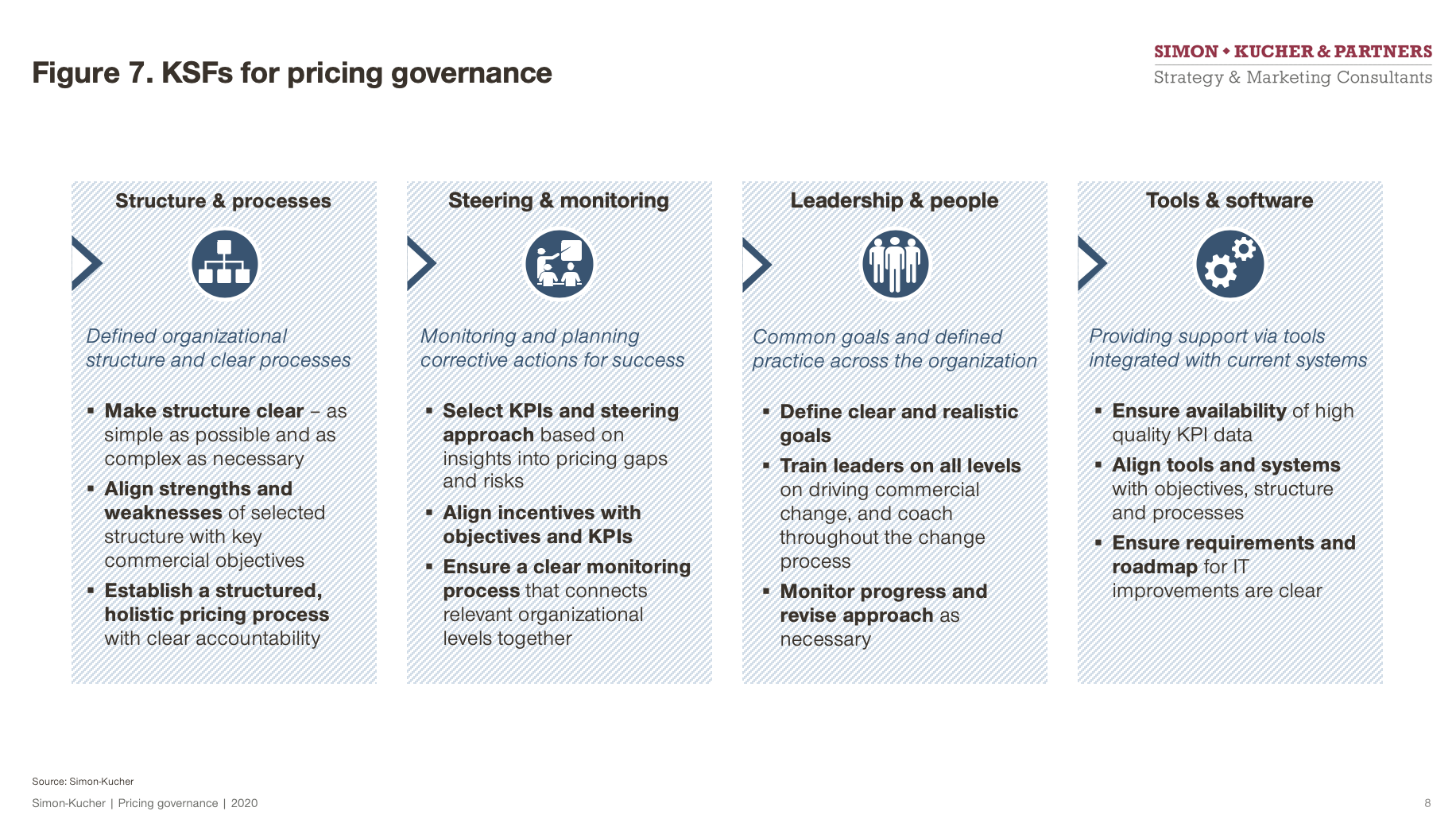
To sum up, it is important for pharma and biotech companies to monitor and update their pricing governance structure and process, as it is one of the fundamental strategic guardrails for a company’s commercial success.
Stephan Schurz is a Partner in Simon-Kucher’s Life Sciences practice, working out of the company’s head office in Bonn, Germany. Dr. Fangting Yu is a Director in Simon-Kucher’s Life Science practice, working out of its US headquarters in Boston.
Addressing Disparities in Psoriasis Trials: Takeda's Strategies for Inclusivity in Clinical Research
April 14th 2025LaShell Robinson, Head of Global Feasibility and Trial Equity at Takeda, speaks about the company's strategies to engage patients in underrepresented populations in its phase III psoriasis trials.
Beyond the Prescription: Pharma's Role in Digital Health Conversations
April 1st 2025Join us for an insightful conversation with Jennifer Harakal, Head of Regulatory Affairs at Canopy Life Sciences, as we unpack the evolving intersection of social media and healthcare decisions. Discover how pharmaceutical companies can navigate regulatory challenges while meaningfully engaging with consumers in digital spaces. Jennifer shares expert strategies for responsible marketing, working with influencers, and creating educational content that bridges the gap between patients and healthcare providers. A must-listen for pharma marketers looking to build trust and compliance in today's social media landscape.